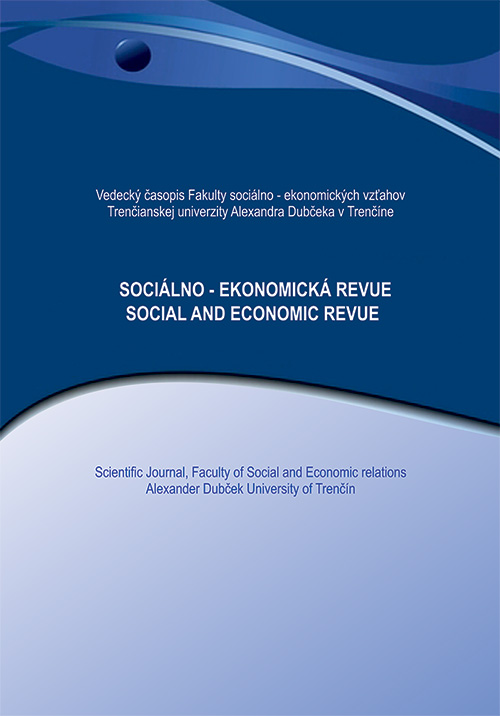SOME REMARKS ON PARADOXES IN MANAGING COMPANY - SELECTED AREAS PERSPECTIVE
The globalization is challenges in every organization. Undoubtedly, today’s organizations face the necessity of dealing with a growing number of various tension and risk factors-generators. Nowadays, as stressed many researchers, management studies referring to paradox theory offer new and vital insights into an array of organizational tensions. Paradoxes has been widely researched in the science literature, nowadays also in the management literature. The authors of this publication have taken into account a wide range of international research literature. The aim of this paper is to theoretically refer to the problems of paradoxes in selected areas of management. The authors indicated the contradictions emerging in the areas such as: risk management, innovation and demography. The literature on paradox theory suggests the existence of four different types of paradox: namely, the paradoxes of organizing, performing, belonging and learning
Release: 2017/1 Pages: 19-26 JEL classification: D81, G32, M21, J20
DOI:
Keywords: paradoxes, risk management, innovation, demographic processes
Section: SOCIAL ASPECTS OF MANAGEMENT
Contacts:
Iwona Gorzeń – Mitka PhD,
Monika Sipa, PhD,
Andrzej Skibiński PhD
Faculty of Management,
Czestochowa University of Technology
Dąbrowskiego 69, 42-201 Częstochowa
Poland
e-mail: iwona.mitka@zim.pcz.pl
Literature:
Balan F.(2015). Testing the Demographic - Economic Paradox for Newly Industrialized Countries: A Panel Data Analysis. Economic Insights – Trends and Challenges Vol.4. No. 2, 1-10
Bogdanienko, J. (2004). Innowacyjność przedsiębiorstw, Wydawnictwo Uniwersytetu Mikołaja Kopernika, Toruń.
Brander , J., Dowrick , S. (1994). The Role of Fertility and Population in Economic Growth, Journal of Population Economics, 7, 1-25
Brondoni, S. M. (2013). Innovation and Imitation for Global Competitive Strategies. The orporation Development Models of US, Japan, Korea, and Taiwan, SYMPHONYA Emerging Issues in Management, n. 1, 2013, 12–27. ISSN: 1593-0319 http://dx.doi.org/10.4468/2013.1.02brondoni 12
Buekens, W. (2013) Coping with the Innovation Paradoxes: the Challenge for a New Game Leadership, International Economic Conference of Sibiu 2013 Post Crisis Economy: Challenges and Opportunities, IECS 2013, Procedia Economics and Finance 6 (2013). 205–212.
D.N. Wail. (2009). Economic growth. Third edition. Taylor and Francis Group. London, New York 2014
Davidson, A. (2011). Will China Outsmart the U.S.? It’s the Economy, The New York Times Magazine December 28, 2011, [acc.: 2017-01-16]. Available at: <http://www.nytimes.com/2012/01/01/magazine/adam-davidson-china-threat.html?pagewanted=all&_r=0>
De Wit, B., Meyer, R. (2007). Synteza strategii, PWE, Warszawa.
Drucker, P.F. (2001). The Essential Drucker, Harper Business, New York.
Francisco, S. (2010). The Innovation Paradox: How Innovation Products Threaten the Innovation Process, Reconstruction: Studies in Contemporary Culture, Vol. 10, No. 2. [acc.: 2017-02-25]. Available at: <http://reconstruction.eserver.org/Issues/102/contents102.shtml>
Gorzeń-Mitka, I. (2007). Ryzyko w eksporcie. Metody i sposoby ograniczania,Key Text, Warszawa.
Gorzeń-Mitka, I. (2015). Management challenges in the context of risk culture. Problems of Management in the 21st Century, 10(2), 60.
Gorzeń-Mitka, I. (2016). Leading Risk Management Determinants of Small and Medium-Sized Enterprises (SMEs): An Exploratory Study in Poland. Eurasian Studies in Business and Economics, 3(1), 289-298.
Gorzeń-Mitka, I. (2017). Bricolage concept in risk culture assessment. European Journal of Sustainable Development, 6(1), 335-343
Hall, E., Smith, A.B. (2013). The CEO’s Guide to: Driving Innovation. Innovation: An Act of Leadership, The Talent Management, Expert DDIO [acc.: 2017-03-01]. Available at: http://www.ddiworld.com/ddi/media/booklets/ceo-guide-to-innovation_bk_ddi.pdf?ext=.pdf
Humphrey, C., Lim, C. Y., Woods, M., & Seow, J. L. (2017). The paradoxes of risk management in the banking sector. British Accounting Review. 49(1), 75–90. DOI: 10.1016/j.bar.2016.09.002
Igartua, J.I., Garrigós, J.A., Hervas-Oliver, J.L. (2010). How innovation management techniques support an open innovation strategy, Research, Technology, Management, Industrial Research Institute, May-June 2010, 41-52.
Jarzabkowski, P., Lê, J. K., & Van de Ven, A. H. (2013). Responding to competing strategic demands: How organizing, belonging, and performing paradoxes coevolve. Strategic Organization, 11(3), 245-280.
Kay, J. (1996). Podstawy sukcesu firmy, PWE, Warszawa.
Kotowska I.E (ed.) (2014)., Uwarunkowania zachowań prokreacyjnych. Niska dzietność w Polsce w kontekście percepcji Polaków.Diagnoza społeczna 2013. Ministerstwo Pracy i Polityki Społecznej, Centrum Rozwoju Zasobów Ludzkich, Warszawa, 41-46
Krzakiewicz, K., Cyfert, Sz. (2016). Imitacja w epoce innowacji – dylemat i paradoks współczesnego zarządzania (Imitation in the period of innovation - dilemma and the paradox of contemporary management), Prace Naukowe Uniwersytetu Ekonomicznego we Wrocławiu, Research Papers of Wrocław University of Economics, nr 420, Strategie. Procesy i praktyki, 179-196.
Lewis, M. (2000). Exploring paradox: Toward a more comprehensive guide. Academy of Management Review, 25: 760-776
Li, H., Zhang , J. (2007). Do High Birth Rates Hamper Economic Growth, The Review of Economics and Statistics, 89(1), 110-117.
Luci, A., Thevenon , O. (2010). Does Economic Development Drive the Fertility Rebound in OECD Countries, p. 5-8, [acc: 28.03.2017] Available at: https://hal.archives-ouvertes.fr/hal-00520948/document,
Mastering Innovation, Exploiting Ideas for Profitable Growth, Deloitte Research Global Manufacturing Study, 2005, Deloitte Development LLC. All rights reserved. [acc.: 2017-01-10]. Available at: https://robertoigarza.files.wordpress.com/2008/03/rep-mastering-innovation-exploiting-ideas-for-profitable-growth-deloitte-2004.pdf
Mesjasz-Lech A. (2012). Efektywność ekonomiczna i sprawność ekologiczna logistyki zwrotnej. Częstochowa: Wydawnictwo Politechniki Częstochowskiej.
Mikes, A. (2009). Risk management and calculative cultures. Management Accounting Research, 20(1), 18-40.
Nieswand B (2011) Theorising Transnational Migration.The status paradox of migration.The status pradox of migration. New Yourk, London Routledge, 15
Pomykalski, A. (2001). Innowacje, Wydawnictwo Politechniki Łódzkiej, Łódź.
Power, M. (2011). Managing the wrong risks for the wrong entities. Risk & Regulation, 22,14-15.
Quinn, R. E., & Cameron, K. S. (Eds.). (1988). Paradox and transformation: Toward a theory of change in organization and management. Cambridge, MA: Ballinger.
Raynor, M.E. (2007) Paradoks strategii, Wydawnictwo Studio Emka, Warszawa.
Rokita, J. (2007). Problemy zarządzania w warunkach nowej ekonomii. In: Rokita, J., Grudzewski, W. (ed.), Zarządzanie strategiczne w warunkach nowej gospodarki, Górnośląska Wyższa Szkoła Handlowa, Katowice.
Silva C. P.,Pedro C.R., Bravo, J. M. ,Vaz-Paralta, S.S. (2006). The paradox of ageing.Instituto Superior de Economia e Gestão – Departamento de Gestão. Working papers series no. 2, 1-21
Skibiński A.(2017). The changes of the Population Structure and its Consequences in Selected EU Countries – Some Aspects.European Journal of Sustainable Development Vol. 6, 1, 357-368
Skibiński, A,. Sipa, M. (2015). Innovative Strategies of Small Enterprises in Poland, 12th International Conference Liberec Economic Forum 2015. Liberec, Technical University of Liberec, 342-352.
Smith, K. K., & Berg, D. N. (1987). Paradoxes of group life: Understanding conflict, paralysis, and movement in group dynamics. San Francisco, CA: Jossey-Bass
Smith, W K., & Lewis, M. W. (2011). Toward a theory of paradox: A dynamic equilibrium model of organizing. Academy of Management Review, 36(2), 381-403.
Somayeh , H., Mohammadi , T., Shariat , B. M. (2013). “Effect of Health on Economic Growth: A Panel Data Study of Developed and Developing Countries”, European Online Journal of Natural and Social Sciences, 2(3), 1273-1278.
Sytze F. Kingma (2015). Paradoxes of risk management: Social responsibility and self-exclusion in Dutch casinos, Culture and Organization, 21(1), 1-22. DOI: 10.1080/14759551.2013.795152
Targalski, J. (ed.) (1999). Przedsiębiorczość i rozwój firmy, Wydawnictwo AE w Krakowie, Kraków.
Tupá, M. (2013). Faktory migrácie pracovnej sily do zahraničia. Social & Economic Revue, 11 (1), 108-122.
Tylec, A. (2007). Ryzyko bezrobocia a polski rynek pracy. [in:] Ryzyko. Zarządzanie ryzykiem w przedsiębiorstwie. Strategie zarządzania ryzykiem w przedsiębiorstwie - zarządzanie ryzykiem projektu, (ed.). J. Bizon - Góreckiej. TNOiK, Bydgoszcz 2007, s. 293-300.
Urbanowska-Sojkin, E. (2016). Paradoksy w zarządzaniu strategicznym przedsiębiorstwami. Prace Naukowe Uniwersytetu Ekonomicznego we Wrocławiu, Research Papers of Wrocław University of Economics nr 420, Strategie. Procesy i praktyki, 363-375.


